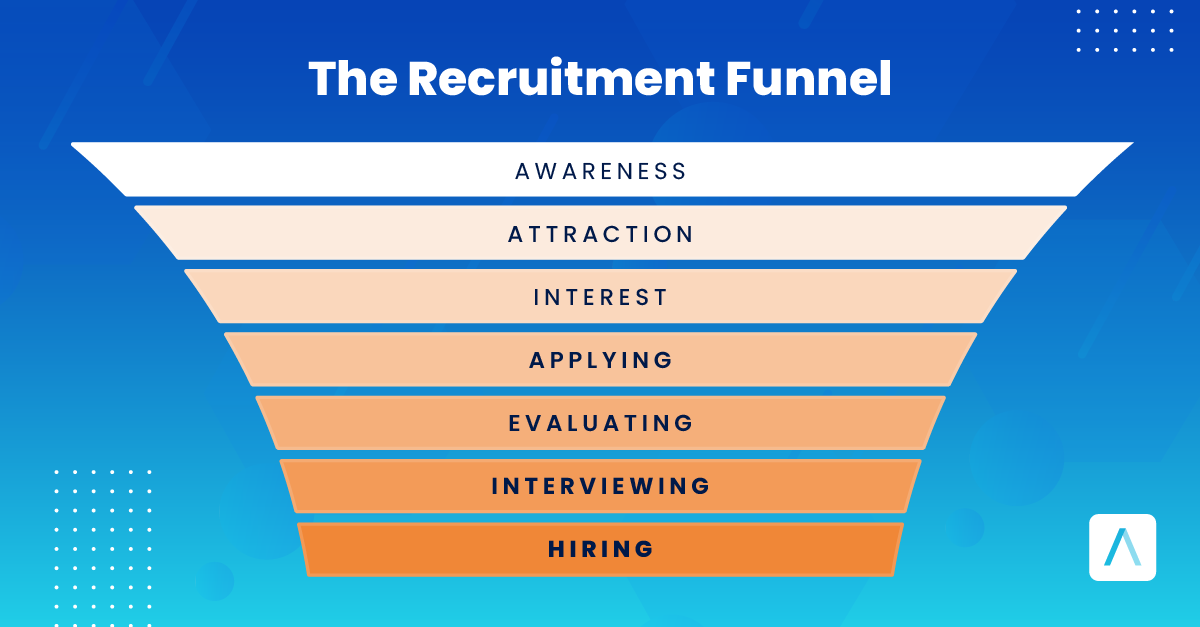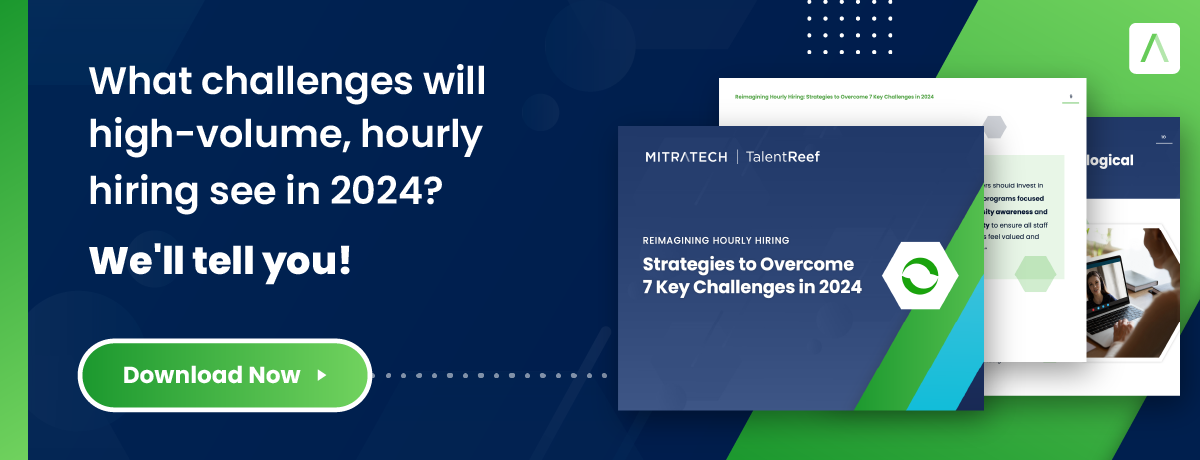Finding the perfect candidate for your job opening is like searching for a needle in a haystack. With countless resumes flooding your inbox and interviews that seem to blur together, it’s easy to get lost in the chaos.
Understanding the recruitment funnel can help make it easier.
In this blog post, we will take you through the ins and outs of navigating the recruitment funnel. We’ll explore what it is and why it’s important, and we’ll break down each stage so you can build an effective strategy from start to finish.
Understanding the Recruitment Funnel
At its core, an organization’s recruitment funnel is a step-by-step process to attract, evaluate, and hire candidates. Just like a sales funnel guides potential customers from awareness to purchase, a recruitment funnel navigates job seekers from initial contact to becoming an employee.
What is a Recruitment Funnel?
A recruitment funnel, also known as a hiring funnel or talent acquisition funnel, is the systematic process that organizations follow to attract, evaluate, and hire candidates for open positions. It acts as a roadmap for companies to navigate through the hiring process efficiently and effectively.
The recruitment funnel can be visualized as a series of stages that candidates move through, from initial awareness of a job opening to receiving an offer. Each stage serves a specific purpose in narrowing down the pool of applicants until only the most qualified individuals remain.
Recruitment Funnel Stages: A Summary
In the first stage of the recruitment funnel, creating awareness, companies employ various strategies such as job postings on websites and social media platforms to attract potential candidates. This helps generate interest and encourages individuals who may be interested in applying. Both this part of the funnel and the next may use applicant tracking software to help streamline the process.
The next stage involves sourcing and screening candidates. Recruiters use different channels like online job boards, employee referrals, and professional networks to find suitable applicants. They then review resumes or conduct preliminary interviews to assess their qualifications.
Once potential candidates are identified, they proceed to the interview process, where recruiters delve deeper into their skills and cultural fit within the organization. Multiple rounds of interviews may be conducted with different stakeholders before making hiring decisions.
During this decision-making stage, recruiters analyze all available information about each candidate’s strengths and weaknesses collected throughout the previous stages. Factors such as experience level, skill set alignment with job requirements, and cultural fit within teams are considered while selecting top contenders for final offers.
Finally comes extending job offers – contacting chosen candidates with attractive compensation packages in hopes they accept employment at your company over other opportunities they may have received during their search.
Why is a Recruitment Funnel Important?
Having a well-defined recruitment funnel is crucial for several reasons. First and foremost, it helps streamline the hiring process by providing structure and clarity. It ensures that every candidate goes through the same evaluation stages, making it easier to compare applicants fairly.
Additionally, understanding your recruitment funnel allows you to identify areas where improvements can be made. By tracking metrics at each stage of the process, you can pinpoint bottlenecks or inefficiencies and make data-driven decisions on how to optimize your recruiting efforts.
Not only does an effective recruitment funnel save time and resources in finding top talent; it also enhances candidate experience. A seamless journey through the various stages of the funnel leaves candidates feeling valued and engaged with your company – even if they don’t ultimately get hired. This is particularly important for high-volume, hourly hires who don’t want to ruin their brand’s reputation with large numbers of people who are also potential customers.
Stages of the Recruitment Funnel
Understanding these stages within a recruitment funnel framework not only helps streamline your hiring process but also enables you to track its effectiveness using key metrics discussed later in this article.
Stages 1 -4: Creating Awareness and Attracting Candidates
The first stage of the recruitment funnel is all about creating awareness. This involves spreading the word about your job openings through various channels such as career websites, social media platforms, and job boards. It’s important to craft compelling job descriptions that attract potential candidates and highlight the unique aspects of your company culture.
Stage 5: Evaluating Candidates
Once you have created awareness, it’s time to source and screen candidates. This involves searching for qualified individuals who match the requirements of the position. Utilize different sourcing strategies like employee referrals, online networking, and direct outreach to engage with potential candidates. After sourcing resumes, screening applicants becomes crucial in order to identify top talent for further consideration.
Stage 6: The Interview Process
Next comes the interview process, where selected candidates are assessed further through phone screenings or in-person interviews. These interviews aim at evaluating their skills, cultural fit, and overall suitability for the role. It’s essential to ask relevant questions that gauge both technical expertise and soft skills.
Stage 5: Making Hiring Decisions
After conducting interviews, it’s time to make hiring decisions based on candidate performance during assessments as well as their alignment with company values and goals. A comprehensive evaluation should be made considering feedback from interviewers involved in each stage of selection.
After Recruitment: Extending Job Offers
Once a suitable candidate has been identified, an offer is extended outlining compensation details along with benefits package information such as healthcare coverage or retirement plans if applicable. Clear communication throughout this stage ensures a smooth transition from candidate to new hire.

Metrics to Track the Recruitment Funnel
Tracking the metrics of your recruitment funnel is essential for understanding its effectiveness and making improvements. By analyzing these key metrics, you can gain valuable insights into the different stages of your hiring process. Here are some important metrics to consider:
- Tracking Conversion Rates: Measure how many candidates progress from one stage of the recruitment funnel to another. This will help you identify any bottlenecks or areas where candidates drop off, enabling you to optimize those stages.
- Cost per Hire: Calculate how much it costs your organization on average to hire a new employee. This metric takes into account various expenses such as job advertisements, recruiter fees, and interview costs. Monitoring this metric helps you evaluate the cost-effectiveness of your recruitment efforts.
- Source of Hire: Determine which channels or methods are most effective in attracting qualified candidates. Tracking this metric allows you to allocate resources appropriately and focus on the sources that yield high-quality applicants.
- Quality of Hire: Assessing the performance and longevity of new hires can provide insights into their overall quality. By measuring productivity, retention rates, and feedback from managers, you can gauge whether your recruiting efforts are resulting in top-notch talent acquisition.
Regularly tracking these metrics helps make data-driven decisions that improve efficiency and overall success in finding top talent for organizations
Tracking Conversion Rates
Tracking conversion rates is a crucial aspect of the recruitment funnel. It helps recruiters understand how successful they are at moving candidates from one stage to the next. By measuring and analyzing conversion rates, companies can identify areas for improvement and optimize their recruitment process.
To track conversion rates effectively, it’s important to define clear metrics for each stage of the funnel. For example, you can measure the percentage of candidates who move from the initial application stage to the interview stage or from the interview stage to receiving job offers.
By tracking these metrics over time, recruiters can identify bottlenecks in their process and take steps to address them. For instance, if there is a significant drop-off in candidate interest after an initial screening call, recruiters may need to reassess their screening criteria or refine their communication with candidates.
Tracking conversion rates also allows companies to compare their performance against industry benchmarks. This helps them benchmark themselves against competitors and set realistic goals for improving their recruitment outcomes.
Tracking conversion rates provides valuable insights into how well your recruitment process is working. It allows you to identify areas for improvement and make informed decisions based on data rather than assumptions or guesswork
Cost per Hire
Cost per hire refers to the total expenses incurred during the hiring process divided by the number of hires made. By calculating this metric, you can gain insights into how much it costs your organization to recruit and onboard new employees.
There are various factors that contribute to the cost per hire, such as advertising expenses, recruiter fees, background checks, and onboarding costs. By understanding these costs, you can identify areas where you may be overspending or find opportunities for cost savings.
Tracking your cost per hire allows you to assess whether your recruitment efforts are efficient and cost-effective. It can help you make informed decisions about budget allocation and determine if adjustments need to be made in sourcing strategies or candidate screening processes.
By keeping a close eye on your cost per hire, you can optimize your recruitment strategy and ensure that resources are allocated efficiently throughout the hiring process.
Source of Hire
One crucial metric to track in the recruitment funnel is the source of hire. This refers to where your candidates are coming from – whether it’s through job boards, social media platforms, employee referrals, or direct applications. Understanding the source of hire can help you determine which channels are most effective in attracting qualified candidates.
By analyzing the source of hire data, you can allocate your resources and budget more effectively. For example, if you find that a significant number of hires come from employee referrals, you may want to invest more in referral programs or incentives for your employees.
Tracking the source of hire also allows you to assess the effectiveness of different recruitment strategies. If a particular channel consistently brings in high-quality candidates who perform well after being hired, it’s worth investing more time and effort into that specific sourcing method.
Furthermore, by knowing where your hires are coming from, you can identify areas for improvement. If certain sources yield low-quality candidates or have high turnover rates, it may be necessary to reassess your approach or consider alternative sourcing methods.
Tracking and analyzing the source of hire provides valuable insights into which recruitment channels are most effective for your organization. By leveraging this information strategically, you can optimize your recruiting efforts and attract top talent efficiently.
Quality of Hire
The quality of hire is a crucial metric that organizations should track and measure as part of their recruitment funnel. It refers to the overall performance, skills, and cultural fit of the candidates once they have been hired. By assessing the quality of hire, companies can evaluate whether their recruitment efforts are successful in attracting top talent.
One way to measure the quality of hire is through performance reviews or evaluations conducted after a certain period since hiring. This allows employers to assess how well employees are meeting job expectations and contributing to the organization’s goals.
Another aspect to consider when evaluating the quality of hire is employee retention. If new hires are leaving shortly after being onboarded, it may indicate that there was a mismatch between candidate expectations and what was offered by the company.
To improve the quality of hire, organizations can enhance their screening process by including assessments or interviews specifically designed to gauge a candidate’s potential for success within their unique work environment.
By continuously monitoring and analyzing data related to the quality of hire metrics, businesses can make informed decisions about refining their recruitment strategies and identifying areas for improvement in order to attract high-quality candidates who will thrive within their organization.
Best Practices for Creating a Recruitment Funnel
When it comes to creating an effective recruitment funnel, there are several best practices that can help you attract top talent and streamline your hiring process. Here are some key tips to keep in mind:
- Define your ideal candidate profile: Before you start sourcing candidates, take the time to clearly define what qualities and skills you’re looking for in an ideal candidate. This will help you target your efforts more effectively.
- Craft compelling job descriptions: Your job descriptions should be concise, yet informative, highlighting the key responsibilities and qualifications required for the role. Use keywords relevant to the position to optimize search engine visibility.
- Leverage multiple sourcing channels: Don’t limit yourself to just one method of sourcing candidates. Utilize online job boards, social media platforms, professional networks, and employee referrals to cast a wider net and reach a diverse pool of applicants.
- Streamline screening processes: Implement pre-screening methods such as phone interviews or skills assessments to quickly identify qualified candidates before moving them forward in the funnel.
- Provide timely feedback: Keep candidates informed about their progress throughout the hiring process by providing regular updates on their application status or interview outcomes.
- Conduct structured interviews: Develop standardized interview questions that assess both technical skills and cultural fit within your organization.
- Collaborate with stakeholders: Involve key team members from different departments in decision-making stages of the recruitment process to ensure alignment on candidate requirements and increase buy-in from all parties involved.
- Track metrics continuously: Regularly measure important recruitment KPIs such as time-to-fill, cost-per-hire, source-of-hire data, etc., so you can identify areas for improvement and make data-driven decisions moving forward.
By following these best practices when creating your recruitment funnel, you can enhance efficiency while attracting high-quality talent who align with your company’s values and goals.
In conclusion, optimizing your recruitment funnel is crucial for attracting top talent to your organization. With TalentReef, you can streamline your hiring process and find the best candidates efficiently. Sign up for a demo today to see how TalentReef can revolutionize your recruitment strategy and help you build a strong team that drives success. Don’t miss out on this opportunity to take your recruitment efforts to the next level!
Our focus? On your success.
Schedule a demo, or learn more about Mitratech’s products, services, and commitment.



